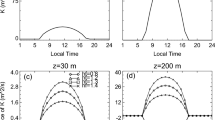Abstract
This paper provides the performance evaluation of the meteorological component of The Air Pollution Model (TAPM), a nestable prognostic model, in predicting meteorological variables in urban areas, for both its surface layer and atmospheric boundary layer (ABL) turbulence parameterizations. The model was modified by incorporating four urban land surface types, replacing the existing single urban surface. Control runs were carried out over the wider area of Kozani, an urban area in NW Greece. The model was evaluated for both surface and ABL meteorological variables by using measurements of near-surface and vertical profiles of wind and temperature. The data were collected by using monitoring surface stations in selected sites as well as an acoustic sounder (SOnic Detection And Ranging (SODAR), up to 300 m above ground) and a radiometer profiler (up to 600 m above ground). The results showed the model demonstrated good performance in predicting the near-surface meteorology in the Kozani region for both a winter and a summer month. In the ABL, the comparison showed that the model’s forecasts generally performed well with respect to the thermal structure (temperature profiles and ABL height) but overestimated wind speed at the heights of comparison (mostly below 200 m) up to 3–4 ms−1.











Similar content being viewed by others
References
Bouris D, Triantafyllou AG, Krestou A, Leivaditou E, Zoumakis N, Rados KG 2016 Development of a high resolution atmospheric urban scale model for energy applications in the built environment, Smart Energy Regions International Conference, UK, 11th and 12th February
Coutts Andrew M, Beringer J, Tapper NJ (2008) Investigating the climatic impact of urban planning strategies through the use of regional climate modelling: a case study for Melbourne, Australia. Int J Clim 28(14):1943–1954
Drew DR, Barlow JF, Lane SE (2013) Observations of wind speed profiles over Greater London, UK, using a Doppler lidar. J Wind Eng Ind Aerodyn 121:98–105. https://doi.org/10.1016/j.jweia.2013.07.019
Duynkerke PG (1988) Application of the E-ε turbulence closure model to the neutral and stable atmospheric boundary layer. J Atmos Sci 45:865–880
Emeis S, Baumann-Stanzer K, Piringer M, Kallistratova M, Kouznetsov R, Yushkov V (2007) Wind and turbulence in the urban boundary layer—analysis from acoustic remote sensing data and fit to analytical relations. Meteorol Zeitschrift 16(4):393–406. https://doi.org/10.1127/0941-2948/2007/0217
European Parliament and Council of the European Union (2012) Directive of the European Parliament and of the Council of 25 October 2012 on energy efficiency, amending Directives 2009/125/EC and 2010/30/EU and repealing Directives 2004/8/EC and 2006/32/EC, 2012/27/EU
Flag DD, Taylor PA (2011) Sensitivity of mesoscale model urban boundary layer meteorology to the scale of urban representation. Atmos Chem Phys 11:2951–2972. https://doi.org/10.5194/acp-11-2951-2011
Hennemuth, Barbara, Weiss, Alexandra, Bosenberg, Jens, Jacob, Daniela, Peters, Gerhard and Pfeiffer, Susanne. Proceedings on International Symposium for the Advancement of Boundary Layer Remote Sensing, Germany, 18–20 July, 2006, 177
Hurley P (1997) An evaluation of several turbulence schemes for the prediction of mean and turbulent fields in complex terrain. Bound–Layer Meteorol 83:43–73
Hurley P (2000) Verification of TAPM meteorological prediction in the Melbourne region for a winter and summer month. Aust Meteorol Mag 49:97–107
Hurley P, Blockley A, Rayner K (2001) Verification of a prognostic meteorological and air pollution model for year-long predictions in the Kwinana region of Western Australia. Atm Environ 35(10):1871–1880. https://doi.org/10.1016/S1352-2310(00)00486-6
Kaimal JC, Finnigan JJ (1994) Atmospheric boundary-layer flows their structure and measurement. Oxford University Press, New York, 289 pp
Lien FS, Yee E, Cheng Y (2004) Simulation of mean flow and turbulence over a 2D building array using high-resolution CFD and a distributed drag force approach. J Wind Eng Ind Aerodyn 92:117–158
Mochida A, Lun IYF (2008) Prediction of wind environment and thermal comfort at pedestrian level in urban area. J Wind Eng Ind Aerodyn 96:1498–1527. https://doi.org/10.1016/j.jweia.2008.02.033
Nunez M, Oke TR (1977) The energy balance of an urban canyon. J Appl Meteorol 16:11–19
PCS. 2000/MF, User Manual, copyright 2005 METEK GmbH
Pelliccioni A, Monti P, Gariazzo C, Leuzzi G (2012) Some characteristics of the urban boundary layer above Rome, Italy, and applicability of Monin–Obukhov similarity. Environ Fluid Mech 12(5):405–428. https://doi.org/10.1007/s10652-012-9246-3
Pielke RA (1984) Mesoscale meteorological modelling. Academic Press, Orlando, 612 pp
Richards PJ, Mallinson GD, McMillan D, Li YF (2002) Pedestrian level wind speeds in downtown Auckland. Wind Struct 5(2–4):151–164. https://doi.org/10.12989/was.2002.5.2_3_4.151
Salamanca F, Martilli A, Tewari M, Chen F (2011) A study of the urban boundary layer using different urban parameterizations and high-resolution urban canopy parameters with WRF, Am Meteorol Soc 1107–1128
Stull RB (1988) An introduction to boundary layer meteorology. Kluwer Academic Publishers, The Netherlands, 666 pp
Willmott C (1981) On the validation of models. Phys Geogr 2:183
Zawar-Reza P, Kingham S, Pearce J (2005) Evaluation of a year long dispersion modeling of PM10 using the mesoscale model TAPM for Christchurch, New Zealand. Sci Total Environ 349(1–3):249–259
Zilitinkevich SS, Mammarella I, Baklanov AA, Joffre SM (2008) The effect of stratification on the aerodynamic roughness length and displacement height. Boundary-Layer Meteorol 129:179–190
Acknowledgments
This work was carried out under the program “Archimedes III,” Subproject 10 “Development and evaluation of a high resolution atmospheric urban canopy model for energy applications in structured areas” funded by the Greek Ministry of Education and Religious Affairs. The project was conceived and initiated by Kostas G. Rados. Work and publication is in fond remembrance of him, an academic, colleague, and dearly missed friend. The authors would also like to thank an anonymous reviewer for careful reviewing of the data presented in this manuscript and constructive comments and suggestions.
Author information
Authors and Affiliations
Corresponding author
Additional information
In memory of Professor Kostas Rados.
Rights and permissions
About this article
Cite this article
Triantafyllou, A.G., Kalogiros, J., Krestou, A. et al. Evaluation of an atmospheric model with surface and ABL meteorological data for energy applications in structured areas. Theor Appl Climatol 135, 1227–1242 (2019). https://doi.org/10.1007/s00704-018-2429-1
Received:
Accepted:
Published:
Issue Date:
DOI: https://doi.org/10.1007/s00704-018-2429-1




